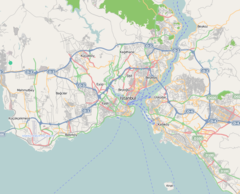Golden Horn Metro Bridge
|
Golden Horn Metro Bridge Haliç Metro Köprüsü |
|
|---|---|

A view of the Golden Horn Metro Bridge, with the Galata Tower at the left end of the frame, and the Galata Bridge in the background.
|
|
| Coordinates | 41°01′22″N 28°57′59″E / 41.022714°N 28.966292°ECoordinates: 41°01′22″N 28°57′59″E / 41.022714°N 28.966292°E |
| Carries | |
| Crosses | Golden Horn |
| Locale | Istanbul |
| Other name(s) | Haliç Metro Crossing Bridge |
| Maintained by |
|
| Characteristics | |
| Design | Cable-stayed bridge |
| Material | Steel |
| Total length | 936 m (3,071 ft) |
| Width | 12.6 m (41 ft) |
| Height | 65 m (213 ft) |
| Longest span | 180 m (590 ft) |
| Clearance above | 13 m (43 ft) |
| History | |
| Designer | |
| Construction begin | January 2, 2009 |
| Construction cost | €146.7 million |
| Opened | February 15, 2014 |
The Golden Horn Metro Bridge (Turkish: Haliç Metro Köprüsü) is a cable-stayed bridge along the M2 line of the Istanbul Metro, spanning the Golden Horn in Istanbul, Turkey. It connects the Beyoğlu and Fatih districts on the European side of Istanbul, and is located between the Galata Bridge and Atatürk Bridge, approximately 200 m (660 ft) east of the latter. It is the fourth bridge across the Golden Horn and entered service on February 15, 2014. The bridge enables a direct connection between the Hacıosman metro station in the Sarıyer district (at the northern end of the M2 line), with the Yenikapı transport hub in the Fatih district (at the southern end of the M2 line.)
The appearance of the bridge project in the general agenda goes back to 1952. After the approval of the metro line by the city's Monument Protection Board and the completion of the tunnels relating to the metro line, a construction bid for the metro bridge spanning the Golden Horn was published by the Metropolitan Municipality. By 2005, a total of 21 proposals were submitted to the Monument Protection Board; however, none were found to be sufficiently in harmony with the city's skyline. A successful design, by architect Hakan Kıran, was controversial from the very beginning. In November 2009, the tower height was reduced from the initially projected 82 m (269 ft) to 65 m (213 ft) because the original height threatened the removal of Istanbul from the UNESCO list of World Heritage sites. The top level of cables was changed from 63 to 55 m (207 to 180 ft), and later in July 2011, it was further lowered to 47 m (154 ft). This revised design was approved in February 2012.
The bridge's conceptual design was carried out by French engineer and bridge specialist Michel Virlogeux, who also designed the Yavuz Sultan Selim Bridge (Third Bosphorus Bridge) currently under construction at the Bosphorus strait in Istanbul. Turkish architect Hakan Kıran was responsible for the architectural design and the construction supervision. Wiecon Consulting Engineers & Architects did the structural engineering work for the bridge. It was built by a consortium of the Italian Astaldi SpA and the Turkish Gülermak Ağır Sanayi İnşaat ve Taahhüt A.Ş. Construction began on January 2, 2009, and was initially planned to be completed within 600 days. The construction time was extended, and the bridge was completed on January 9, 2013. Test runs of the metro line on the bridge began the next day, and the bridge went into service on 15 February 2014. Budgeted cost of the construction was €146.7 million.
...
Wikipedia

